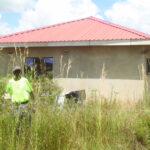As Zimbabwe prepares to host the Southern African Development Community (Sadc) summit next month, a wave of controversy has erupted over the government’s lavish spending on infrastructure projects in the face of a dire humanitarian crisis. President Emmerson Mnangagwa, set to assume the Sadc chairmanship, has embarked on an ambitious beautification project for Harare, with the aim of presenting a polished image to regional leaders. However, critics argue that this expenditure is a misallocation of resources, particularly given the dire food insecurity plaguing the nation.
The summit, scheduled for August 17th and 18th, has triggered a flurry of activity in Harare, with road rehabilitation projects, the construction of luxurious villas for visiting heads of state, and a comprehensive marketing campaign all in full swing. While the government has remained tight-lipped about the exact cost of these preparations, sources within one of the contracted road construction companies have pegged the figure at over US$220 million, The News Day has reported.
“Several tributary roads are being refurbished, others being widened while in some areas, roads are being constructed from scratch. We are talking about a combined 250 kilometres being worked on and its worth more than US$220 million,” revealed a source familiar with the project.
Information, Publicity and Broadcasting Services Minister Jenfan Muswere, in a post-Cabinet briefing, confirmed that 90% of the road works have been completed, highlighting the extensive scope of the project.
“Rehabilitation of Old Mazowe Road is underway and the scope of works includes construction and landscaping of Old Mazowe Road from Westgate Traffic Circle (Roundabout) to Mt Hampden; the Loop Road and New Parliament Building access roads; and the New Parliament Boulevard to the intersection with the Bindura Road,” Muswere stated.
“Government is also rehabilitating Greater Harare roads and the scope of works includes rehabilitation, street lighting and landscaping of 37 roads in the Greater Harare area that link the Robert Gabriel Mugabe International Airport to the City and also to Mt Hampden and New Parliament Building in particular. The overall progress of works is 90% and the target completion date is 30th July, 2024,” he added.
In a further display of lavish spending, the government has commissioned the construction of 18 state-of-the-art villas in Mt Hampden to accommodate the Sadc Heads of State. These villas, built by a team of 500 Swiss experts, are expected to house the regional leaders for a maximum of two nights, with most of the construction materials imported.
The government has also launched a comprehensive marketing campaign for the summit, with billboards emblazoned on buses plying Harare routes. This effort underscores the government’s determination to showcase a positive image of Zimbabwe to the regional community.
However, the government’s expenditure on these projects has been met with widespread criticism, with many questioning the priorities of the ruling party. Social justice advocate Tendai Mbofana believes that President Mnangagwa’s focus on the summit is a calculated attempt to rebrand his image, particularly in light of the controversial 2023 elections.
“His [Mnangagwa] election victory last year was tainted with allegations of electoral fraud, widespread intimidation of voters, biased state media, a compromised electoral body and a brutal crackdown on the opposition. As much as the region Heads of State failed to take any concrete action on the damning report, Mnangagwa, nonetheless, is fully aware that he is not regarded as the legitimate leader of Zimbabwe even by his own fellow counterparts in Sadc.”
“Therefore, becoming the chair of this body and hosting the summit is, to him, a way of packaging himself as a legitimate President who has been recognised by fellow Sadc leaders. The noise and circus around this meeting of Sadc Heads of State and government is designed to somehow counter the damning Sadc election observer mission report.”
Political commentator Pardon Taodzera echoes these sentiments, highlighting the stark contrast between the government’s lavish spending and the dire state of the nation’s economy.
“It’s a case of wrong priorities. Millions are facing starvation, hospitals are empty and pupils do not have textbooks, then we focus on preparing for a two-day event? I think it’s a case of wrong priorities,” he said.
The government’s own estimates reveal that over half of the population is currently food insecure and requires food aid, a consequence of the El Nino-induced drought that has ravaged the country. President Mnangagwa has declared the drought a national disaster and appealed for US$3 billion in international aid to address the humanitarian crisis.
The government’s decision to prioritize a summit over the basic needs of its citizens has sparked outrage among many Zimbabweans. They question the government’s commitment to their well-being, particularly when faced with such a dire situation. The Sadc summit, while a significant event, has become a symbol of the government’s misplaced priorities, highlighting the disconnect between the ruling elite and the struggles of ordinary Zimbabweans.












